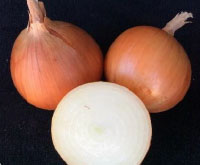
OUTSTANDING QUALITIES
- Unique sowing and marketing period
- Mid-maturing intermediate day brown onion
- High heat tolerance – adapted to high temperature conditions during summer production
- Excellent quality – attractive, medium to large, globe shaped bulbs
- High yielder
Capricorn is a mid-maturing, intermediate day, brown onion variety with a distinctive sowing period. The latter characteristic makes Capricorn highly sought after as it enables producers to penetrate a unique onion marketing period with high quality bulbs. Capricorn’s bulbs are uniform, firm and globe shaped with an attractive brown skin. In addition, Capricorn has a good storage potential, enabling producers to market the bulbs over an extended period. Capricorn has a vigorous root system with intermediate resistance against Pink root/Pt (Phoma terrestris syn. Pyrenochaeta terrestris).
SPECIAL VARIETAL REQUIREMENTS
- Recommended for production around the 23.5° latitude line, Tropic of Capricorn.
- Suggested sowing period is from week 45 to week 50 (November and December) in the areas of Limpopo province, Botswana and Namibia near this latitude line
|
CHARACTERISTIC* |
CAPRICORN |
|
KIND AND TYPE |
F1 hybrid, mid season, intermediate day brown onion (Allium cepa L.) |
|
MATURITY |
Medium, 21 to 26 weeks after direct seeding. Maturity depends on sowing date, production location and seasonal variations (photoperiod and temperature) |
|
BULB SHAPE |
Globe to high globe |
|
BULB SIZE |
Medium to large (50 – 90 mm) – bulb size is influenced by the plant population |
|
BULB UNIFORMITY (SHAPE AND SIZE) |
Very good |
|
BULB NECK SIZE AND QUALITIES |
Medium to fine (thin) and tight |
|
BULB FIRMNESS |
Very good |
|
BULB TUNIC (SKIN/SCALE LEAF) COLOUR |
Excellent colour: brown |
|
TUNIC RETENTION AND QUALITY |
Very good and tough |
|
STORABILITY/SHELF LIFE |
Good (3½ to 4 months) – enables producers to market bulbs over an extended period. Storage potential depends on the storage conditions (temperature and relative humidity). |
|
FLESH COLOUR |
White |
|
TASTE |
Mildly pungent |
|
LEAF/FOLIAGE HEALTH AND GROWTH HABIT |
Good and upright |
|
LEAF/FOLIAGE COLOUR |
Green |
|
BOLTING REACTION |
Slow – high tolerance (depends on/related to the sowing date) |
|
DISEASE RESISTANCE (SCIENTIFIC) |
Intermediate resistance: Phoma terrestris (Pt) |
|
GROWING AREA |
Grown between 22.5 – 24.5° latitude. However, the optimum production area is near the 23.5° latitude line, Tropic of Capricorn. Suggested sowing period is from week 45 to week 50 (November and December) in the areas of Limpopo province, Botswana and Namibia close to this latitude line. |
|
AVERAGE SEED COUNT |
220 – 320 seeds per gram or 220 000 – 320 000 seeds per kilogram |
|
SUGGESTED SOWING DENSITY |
Density depends on the size requirement of the bulbs and the target market/uses of the final product, however we suggest: Final population of 750 000 – 950 000 plants per hectare |
|
SEED REQUIREMENT PER HECTARE |
Direct sowing: 900 000 to 1 200 000 seeds per hectare / 3.5 – 4.0 kg seed per hectare |
|
MARKET USES |
Bunched, fresh market, pre-pack and processing |
|
SPECIAL FEATURES, BENEFITS AND REMARKS |
Excellent yield potential. Unique summer sowing period during November and December (week 45 to week 50) in areas of Limpopo province, Botswana and Namibia around the Tropic of Capricorn latitude line. |

